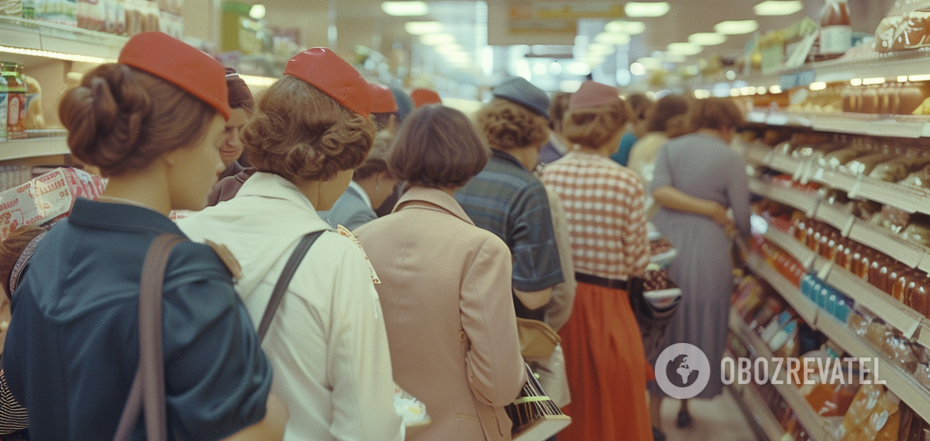Life
Why there were always queues in the USSR: even cigarettes were not available
People who remember the USSR well call queues one of their most difficult memories. Sometimes you had to stand in line for several hours to get a product and go through more than one conflict with your neighbors in line.
Yes, queues still exist today. Just look at Apple stores on the day the new iPhone is released. But these are isolated cases. In the Soviet Union, you had to stand in line for literally everything. Maksym Mirovych, a blogger and researcher of everyday life in the USSR, told us more about the queues of that time.
In particular, he emphasized that the total shortage and, as a result, the need to stand for hours in the hope of bringing home at least something was not the result of Gorbachev's perestroika, as those who want to return the Union now claim. In the 1960 film Oleg Popov's Housewarming, they are shown in full detail.
Why the queues appeared
Queues began to appear because of the shortage of goods that resulted from the planned Soviet economy. Demand often far exceeded the planned supply, so people gathered wherever they could get something, hoping that there would be enough goods for them.
The production plan was approved by the leaders of the Communist Party and was not shaped by actual demand, as in a market economy. Therefore, it was not uncommon for garlic presses to be produced with a surplus, but vacuum cleaners were in short supply. The press could be bought at any time and was in every home, but there were huge queues for vacuum cleaners. Such planning mistakes were constant, and thus the queues were ubiquitous.
Another problem created by the planned economy was the low quality of goods. The lack of competition did not encourage manufacturers to improve what they produced - people would still buy up as long as they had something. There was a huge demand even for something that would break in a month. Soviet citizens believed that even such an unreliable product was better than nothing at all. And they repaired what they bought themselves.
Which goods had the longest queues
In short, Soviet people had to stand in line for literally everything. There were even queues for housing or cars that could last for decades, but they were monitored by Soviet bureaucrats who could, by the way, trade places and shuffle the order for a fee. Even very simple household goods had to be physically defended.
Food
You had to stand in line even to buy rotten fruit in an unpleasant, smelly vegetable store. What can we say about relatively high-quality products, such as raw dried, or smoked sausage. People even traveled to richer regions to buy them. There were so-called sausage trains that people used to ride on weekends to get food for their families.
People were almost always lining up for exotic fruits, such as tangerines or bananas. Only apples were always available. Polish frozen vegetables, Hungarian green peas, and Bulgarian ketchup, as well as high-quality sweets, were also appreciated and "gathered an audience."
At the same time, each product had to stand separately. Trade was not organized the way it is now, when almost all consumer goods can be bought in one supermarket. Even in department stores, there was a separate line for each department - dairy, meat, and vegetable. That's why whole families often went shopping, leaving one family member in a separate line.
Clothing and footwear
It was almost impossible to buy high-quality ready-made clothes in the USSR. That's why almost every woman knew how to sew and knit. The appearance of bologna jackets or boots, which are difficult to make at home, caused a real stir. At the same time, there were often situations when only one model or only a few sizes appeared in the store. People even took what didn't fit, because they had no other choice. Unsuitable clothes were altered. Often, store employees sold clothes through the back door. But the price in this case was higher.
Cosmetics and hygiene products
The Soviet industry was set up to supply the military-industrial complex, and the needs of ordinary citizens were taken care of last. That's why even more or less affordable toilet paper appeared in the USSR only in the early 70s. Cosmetics and hygiene products did not fall under the category of essential goods, so they were always in short supply. And this caused queues. After standing in line for several hours, people would buy dozens of rolls of toilet paper to postpone their next visit as long as possible. The purchased items were proudly carried home, with the bundle wrapped around their necks like a necklace.
Alcohol and cigarettes
It was not uncommon for a Soviet person to smoke so-called makhorka or self-potted tobacco. High-quality cigarettes were a real rarity in stores. If you managed to get a pack of imported cigarettes, they were cherished, just as expensive cigars are now.
The situation with alcohol became particularly acute under Gorbachev, who decided to introduce a "dry law." According to its terms, vodka was sold only in clearly defined stores and for a limited time. Therefore, a large crowd was already gathering at the liquor store's entrance before it opened.
Subscribe to OBOZ.UA channels in Telegram and Viber to keep up with the latest events.



























